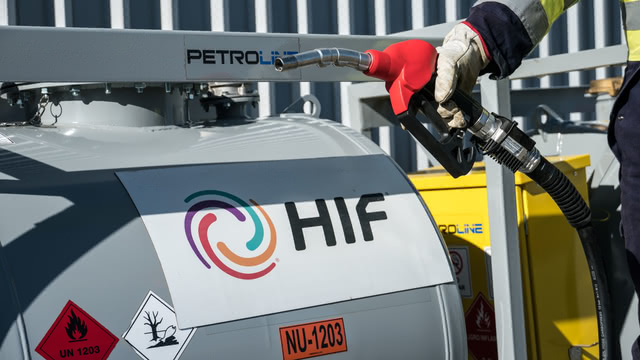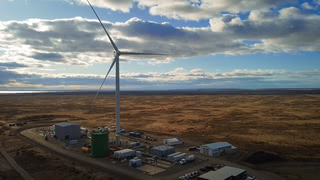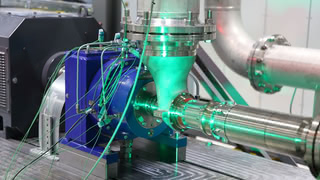What's up with the Production of E-Fuels in Chile?
In 2022, Siemens Energy, Porsche, and HIF inaugurated a pilot plant for the production of E-Methanol and E-Gasoline in southern Chile. The Haru Oni plant was intended to be just the beginning — with plans for large-scale production just a few years later. However, it does not look like that will ever happen.

Given enough energy, it is possible to turn water and carbon dioxide into pretty much any hydrocarbon molecule. This is the key idea of E-Fuels: chemical energy carriers made with renewable electricity that can be used as a direct drop-in replacement for existing fossil fuels.
A major reason for their appeal is that not much would have to change. E-fuels can power existing cars and can be distributed via existing infrastructure like gas stations.
There is just one problem. E-Fuels are extremely inefficient. The amount of energy required to make them is, therefore, enormous. If burned in a combustion engine, E-Fuels combine two very inefficient processes. Their production involves losses during every conversion step, and combustion engines have never been particularly efficient to begin with.
E-fuels will, in all likelihood, remain expensive and scarce. Due to their downsides, they are primarily discussed as a solution for sectors where direct electrification and batteries are not feasible — such as long-distance shipping or aviation.
Yet, despite their obvious downsides and extreme inefficiencies, E-Fuels are still seen by some as a future solution for cars — and a savior of roaring combustion engines. The debate is primarily happening in Germany, but E-Fuels have their fans elsewhere, too.
"Technologieneutralität," sometimes translated as technological neutrality or technology openness, has become a major talking point in German politics and is pushed by lobbying organizations like the Efuel Alliance, a spin-off from the German oil supply industry organization UNITY. (Most members of UNITY and the Efuel Alliance are gas station operators and their suppliers.)
The core idea of E-Fuels is to use carbon dioxide and Hydrogen made with green electricity and turn them into energy-dense molecules. To make E-Fuels even remotely feasible, the idea is typically to produce them in remote locations with ample potential for renewable energy. One pilot project that follows this idea is Haru Oni — an E-Fuels plant in Chile's windy southern Magallanes region.
E-Fuels project in Chile involves Siemens Energy and Porsche
In 2020, the German government adopted a National Hydrogen Strategy. The governing coalition of social democrats (SPD) and conservatives (CDU/CSU) saw Hydrogen and technologies based on it as a major tool to fight climate change. And the government was willing to put money on the table to make it happen.
In late 2020, Siemens Energy was one of the first companies to receive a grant as a result of Germany's Hydrogen strategy. Siemens Energy received around eight million Euros for the Haru Oni plant in Chile, a collaboration with other partner companies, including, most notably, car maker Porsche.
I received multiple documents related to Haru Oni through a freedom of information request to Germany's Ministry of Economics.
It is noteworthy that in the internal documents, the project was described as the Haru Oni Power-to-Methanol plant. Yet, the public perception was quite different, in government press releases and media reports, Haru Oni was described as a plant producing E-Fuels for cars, without ever mentioning Methanol.
The operator of Haru Oni is the company HIF (Highly Innovative Fuels). Its majority owner is AME (Andes Mining and Energy), a Chilean energy and mining company.
On its web page, HIF mentions construction costs of 78 million US dollars for Haru Oni. With a subsidy grant of 8 million Euros, around one-tenth was funded by German taxpayer money. On an older version of its web page, HIF was putting the costs at 51 million US dollars. However, such cost increases are unsurprising for such a project.
As mentioned, Haru Oni was subsidized as part of Germany's National Hydrogen Strategy. Responsible for that hydrogen strategy was the then-head of the department for energy policy, heat, and efficiency in Germany's Ministry of Economics, Thorsten Herdan. Herdan had previously worked for the German Mechanical Engineering Industry Association (VDMA) and CIMAC, the International Council on Combustion Engines.
After Germany's federal election in 2021 and a change in Germany's government, Herdan left the ministry. In 2022, he joined HIF — the company that operates Haru Oni. Before switching roles, Herdan personally signed the grant for the plant's subsidies in 2020.
From Hydrogen and CO₂ to Methanol and Gasoline
The Haru Oni pilot plant is powered by a single wind turbine. It powers electrolyzers to make green Hydrogen. Siemens Energy provided both the electrolyzer and the wind turbine.
Hydrogen and CO₂ are combined in another process to Methanol. The Methanol synthesis utilizes uses technology from Johnson Matthey. While Siemens Energy and its partners originally claimed that Haru Oni would use CO₂ from direct air capture, the direct air capture plant was delayed for multiple years, and CO₂ is delivered in trucks from a brewery.
According to HIF, Haru Oni can produce 750,000 liters of Methanol annually (around 600 tons). It is not a lot; other comparable pilot projects have much larger capacities.
From that Methanol, only a small share is further processed in a Methanol-to-Gasoline process utilizing technology from ExxonMobil. Methanol-to-Gasoline technology was originally developed by Mobil, which later became part of ExxonMobil, in the 1970s and 1980s. (I have briefly covered the origins of Methanol-to-Gasoline and Methanol-to-Olefins technology here.)
Haru Oni's production capacity for gasoline is 130,000 liters (around 34,000 gallons). Whether that capacity is actually reached is unclear. HIF does not publish production numbers and has not responded to questions for this article.
All production steps already exist in similar ways elsewhere. CO₂-to-Methanol technology was first developed in Iceland by the company Carbon Recycling International, which has operated a pilot plant since 2012. Methanol-to-Gasoline technology is sometimes used as part of a process to make liquid fuel from fossil Methane gas. The largest Methanol-to-Gasoline plant is in Turkmenistan.
An expert familiar with HIF's technology told me in a background conversation that the main innovation of Haru Oni's technology is its flexible operation. It produces only when wind energy is available.
It is noteworthy that Haru Oni's main product is Methanol, not gasoline. This matches the description in internal documents, where Siemens Energy refers to it as a Power-to-Methanol project. Yet, it does not match the public perception.
The gasoline production volumes are tiny. To put it in perspective, an average-sized gas station sells multiple million liters of fuel annually. Haru Oni's output of 130,000 liters would, therefore, not even be enough to supply a single gas station.
What happens to the fuel produced in Haru Oni? Porsche uses some of it in race cars. In 2024, Porsche announced that it used E-Fuels from Haur Oni in its 2024 Mobil 1 Supercup.
Porsche is not the only race car organizer that likes to advertise its use of E-Fuels. However, in many other cases, operations of race cars with E-Fuels have been implied or advertised when, in reality, those cars were using biofuels. (There is often confusion around exact terminology, and terms like "synthetic fuels" are sometimes deliberately used to confuse the debate and distract from the fact that E-Fuels are barely available in practice.)
Unlike other actors, Porsche can at least claim to truly use E-Fuels in some race car events. However, the emission reduction impact of using tiny amounts of E-Fuels in race cars is not very relevant. The companies building Haru Oni had promised something different: a rapid expansion of E-Fuels production in a very short amount of time.
After the plant's inauguration, HIF wrote on the project's web page: "The output of the demonstration plant will be 130,000 liters of synthetic gasoline. In two steps, capacity is planned to be increased to 55 million liters e-gasoline per year by 2025 and over 550 million liters per year by 2027."
That would have been a 400-fold increase by 2025 and a 4,000-fold increase by 2027.
(Until April this year, HIF's web page claimed: "Mass production of e-Fuels is expected from 2026." HIF changed it after the German version of this article was published; it now says 2029.)
As of 2025, there are no signs of gigantic e-fuel factories in Chile. HIF's web page mentions a planned plant at a location called Cabo Negro, not far from the Haru Oni pilot plant. Cabo Negro is already home to a fossil-based Methanol production plant by another company, as well as an industrial harbor. Therefore, infrastructure for exports would be available.
It has been apparent for some time that these expansion plans are unlikely to be realized anytime soon. Back in October 2022, even before Haru Oni opened, HIF announced the withdrawal of an environmental permit application for a wind farm that was intended to supply energy to the Cabo Negro plant.
In December 2023, HIF resubmitted the application for the environmental permit. Since then, there have been no further updates about this project.
The Cabo Negro project in Chile, with a planned production capacity of 175,000 tons of E-Methanol per year – approximately 300 times that of Haru Oni – is not the only one announced by HIF. The company also has plans for a plant with a capacity of 700,000 tons in Uruguay, another one with 1.4 million tons in Texas (USA), and a project in Brazil with 800,000 tons. Further announced project locations include Morocco and the Australian island of Tasmania.
However, all of these projects are currently just announcements and plans. No construction start or final investment decision has been announced for any of them. HIF has not responded to questions about the status of these projects.
The source of Carbon Dioxide
The production of E-Gasoline — and also of E-Methanol — requires not only vast amounts of energy but also a source of carbon dioxide. This is a challenge that is often not acknowledged in discussions about E-Fuels.
Where that carbon dioxide comes from is a key question for all such technologies commonly referred to as Carbon Capture and Utilization (CCU).
It would be possible to source CO₂ from emission sources like fossil fuel power plants or industrial facilities. However, it is important to consider that the carbon embedded in those E-Fuels will still be released into the atmosphere.
It is, in some sense, a double use of carbon dioxide; emissions into the atmosphere are delayed. That can still lead to limited emission reductions. However, it is not climate-neutral and, therefore, not a long-term solution.
A possibility is to source carbon dioxide from biomass. For example, during the production of biomethane or bioethanol, relatively pure carbon dioxide is produced as a by-product. Whether that is climate-friendly depends on the overall emissions of these processes. Bioenergy crops can often have substantial indirect greenhouse gas emissions during their production and due to land-use impacts.
Finally, there is the possibility of using direct air capture (DAC) technology to directly filter carbon dioxide from the air, an extremely energy-hungry process. Using direct air capture for E-Fuels would make an already inefficient process even less efficient and more costly.
The missing Direct Air Capture plant
HIF and its partners had claimed initially that direct air capture would be used for their Haru Oni plant. When Haru Oni was inaugurated in 2022, Siemens Energy wrote on its web page: "Synthetic fuel is produced from water, wind energy and CO₂ captured from the air." The project's web page featured a graphical illustration with a direct air capture plant.
However, in March 2023, a video published by Donut Media, a YouTube channel made by car enthusiasts, uncovered that those claims about using "CO₂ captured from the air" were untrue. The place where the DAC plant was supposed to be was empty. HIF received CO₂ in trucks coming from a brewery.
Looking at previous announcements by HIF, it appears that the company had trouble finding suitable direct air capture technology. Initially, the technology for direct air capture was to be provided by Global Thermostat. It has, in the meantime, been acquired by another direct air capture company named Zero Carbon Systems.
After the mentioned YouTube video and media reports pointing out the missing direct air capture unit, HIF announced a new plan in March 2023. Baker Hughes, a company selling oil industry equipment and one of HIF's investors, had previously bought the direct air capture start-up Mosaic Materials. Now, the plan was to use Mosaic Materials' technology for Haru Oni.
A few months later, HIF announced yet another plan for its direct air capture unit. Now, HIF intends to use direct air capture technology from Volkswagen and MAN. The installation was announced for 2024. In December 2024, HIF announced that construction of the direct air capture unit had started. HIF has not yet announced that the direct air capture plant is operational.
According to internal documents, HIF, its partners, and the German economics ministry, which provided the subsidies, likely knew about expected problems and delays with the construction of the direct air capture unit early on. A cost calculation from Siemens Energy lists not only a "CO₂ direct air capture plant" but also a "CO₂ plant brewery (backup)".
The episode about the likely still not operational direct air capture unit shows that the companies behind Haru Oni were not communicating honestly about the project. However, more relevant than the carbon dioxide source for a small pilot plant is how future potentially much larger plants will receive their carbon dioxide — if they are ever built.
Shipping CO₂ from Japan to Australia - or from Spain to Morocco?
In early 2024, HIF and several Japanese companies announced plans to ship carbon dioxide from industrial facilities in Japan to HIF's future production facilities in the USA, Australia, or Chile.
Interviewed by Euractiv, HIF's Thorsten Herdan said in 2024 that the company is considering shipping carbon dioxide from industrial sources in Spain to Morocco. The background is that the European Union plans to restrict carbon dioxide sources for Renewable Fuels of Non-Biological Origin (RFNBOs, an EU policy term for E-Fuels and Hydrogen). While industrial CO₂ sources of fossil origin are allowed temporarily under certain circumstances, they need to come from facilities covered by a carbon pricing system.
While it remains uncertain whether those plans to ship carbon dioxide will ever be realized, that they are even discussed shows that sourcing carbon dioxide can be a significant problem for E-Fuels. Direct air capture is too expensive and likely not feasible at scale for the foreseeable future.
Is it about E-Methanol or E-Gasoline?
As mentioned earlier, there is a noteworthy discrepancy between what HIF's Haru Oni plant actually produces — primarily Methanol — and its public perception. HIF and its partners Siemens Energy and Porsche advertised the project with plenty of pictures of gas pumps and Porsche cars.
E-Methanol is a potential solution for sectors like shipping or the production of plastics or aviation fuels. However, this has little to do with making fuels for cars. While it is possible to build Methanol-powered cars — they have a certain market share in China — this is usually not what people mean when they discuss E-Fuels. Methanol cannot be used as a drop-in replacement for gasoline or diesel engines.
Looking not just at the pictures on its web page but at HIF's actual projects, it appears that the company is primarily looking into those other uses of Methanol as its future business.
In 2023, Energy Intelligence reported that HIF had dropped plans for a Methanol-to-Gasoline unit at its planned plant in Texas.
Also in 2023, HIF announced a collaboration with Honeywell for the production of synthetic aviation fuels.
Honeywell is a US technology company that has built multiple Methanol-to-Olefins plants in China. These plants produce plastic from Methanol made via coal gasification.
This technology can also serve as an intermediate step to make synthetic aviation fuels from Methanol, and Honeywell is marketing such a Methanol-to-Jet technology.
In HIF's last press release about its Cabo Negro plant in Chile, HIF writes that the plant "is expected to produce over 173,000 tons per year of eMethanol, with the potential to be converted into 70,000 tons/year of eGasoline and 8,030 tons/year of eLG." (eLG refers to E-Methane.) Note that HIF merely writes that there is the "potential" for this Methanol to be converted into gasoline. It remains unclear whether HIF actually plans to do that.
What remains of those grand plans to produce large amounts of E-Fuels for cars in Chile's windy south? Not much. A small pilot plant that supplies insignificant volumes of fuel for a few Porsche race car events. A HIF lobbyist who was previously responsible for providing subsidies for the project of his future employer — an example of a questionable "revolving door" between politics and businesses.
There is a huge discrepancy between HIF's announcements and its actual project development. HIF announced multiple massive projects, with staggering production volumes. Its press releases regularly claim that HIF and its various partners "accelerate" E-Fuels development. Yet, not a single one of the company's projects appears to be making any meaningful progress.
There also remains a strange discrepancy between the public perception and the actual plans. Even if HIF will eventually implement some of its grand announcements — which appears doubtful, to say the least — it will likely produce E-Methanol from biogenic and industrial carbon dioxide — rather than E-Gasoline for cars using CO₂ from the air.
Author: Hanno Böck
Brief
-
A planned E-Methanol plant at a waste incinerator in Zella-Mehlis (Germany) will not be built. Costs were originally estimated at around 23 Million Euros in a feasibility study, but later cost estimates were more than 80 Million. The incinerator's operator, ZASt, has returned a funding grant.
-
A preprint by Philipp Glaum, Fabian Neumann, Markus Millinger, and Tom Brown discusses the idea of a Minimal Methanol Economy. Brown also posted a summary blog post. (I previously covered some of these ideas here.)
-
The CEOs of two Swedish waste processing companies — Tekniska verken Linköping and Umeå Energi — argue in the publication Aktuell Hållbarhet that Swedish policy should provide better incentives for separating recyclable material from mixed waste. Both companies have plans for wasting sorting facilities. I mention this because it has a connection to a story I wrote earlier this year about the E-Methanol company Liquid Wind. Liquid Wind plans to build one of its plants near Umeå Energi's waste incinerator, Dåvaverket, and utilize its CO₂. According to Liquid Wind's web page, "the fossil share of carbon dioxide emissions from the Dåva cogeneration plant will be captured for long-term storage in the bedrock using Carbon Capture and Storage (CCS)." By pre-sorting recyclable waste, Umeå Energi could increase its biogenic share and reduce the need for CCS.
-
Climeworks, the direct air capture company from Switzerland, recently announced a significant reduction in its workforce. An article by Heimildin takes a critical look at Climeworks' existing plants in Iceland and their poor performance.
-
Peter Tom Jones, a scientist from KU Leuven in Belgium, thinks that Europe should mine more metals crucial for the energy transition. In a documentary available on YouTube (2024), Jones shares his thoughts and investigates mining sites in northern Europe. Strong watch recommendation!
-
I made a YouTube video about the MF Hydra, a ferry in Norway powered by liquefied Hydrogen. I covered the story of the MF Hydra in a recent newsletter.



